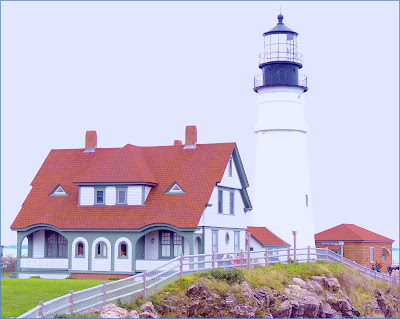Portland Head Light
 |
| Photo by: Cherri Nowell |
Portland Head Light in Southern Maine at Fort Williams Park in Cape Elizabeth marks the state's busiest harbor, boasting a combination of historic significance and beauty. It is possibly the most visited, photographed and painted lighthouse in the United States. The setting particularly inspired Henry Wadsworth Longfellow, who found the tranquil beauty well suited to writing poetry. This is the lighthouse where he wrote his poem ‘The Lighthouse.’
Maine was part of the Massachusetts Bay Colony in the 18th century and Portland (known as Falmouth until 1786) had become one of the busiest ports in America by the late 1700's. In 1784 John Hancock was governor of the Bay Colony and authorized construction of this first light house in Maine. Construction didn't begin on Portland Headlight until 1787, before funds became available.
At that time, while Maine was still part of the state of Massachusetts, George Washington engaged two masons from the town of Portland, Jonathan Bryant and John Nichols, and instructed them to take charge of the construction of the lighthouse on Portland Head. Washington reminded them that the early government was poor, and said that the materials used to build the lighthouse should be taken from the fields and shores, which could be handled nicely when hauled by oxen on a drag. The original plans called for the tower to be 58 feet tall. When the masons completed this task they climbed to the top of the tower and realized that it would not be visible beyond the headlands to the south, so it was raised to 72 feet.
The tower was built of rubblestone, and Washington gave the masons four years to build it. While it was under construction in 1789, the federal government was being formed and for a while it looked as though the lighthouse would not be finished. Following passage of their ninth law, the first congress made an appropriation and authorized the Secretary of the Treasury, Alexander Hamilton, to inform the mechanics that they could go on with the completion of the tower. On August 10, 1790, the second session of congress appropriated a sum not to exceed $1500, and under the direction of the President, “to cause the said lighthouse to be finished and completed accordingly.” The tower was completed during 1790 and first lit January 10, 1791. The tower now stands at 101 feet above sea level and it's light can be seen 26 miles to seaward on a clear evening.
President George Washington appointed its first keeper, Capt. Joseph Greenleaf. Since its construction, the tower has never been
rebuilt. The light was originally fueled by whale-oil lamps and in 1855, a fourth-order lens was installed but replaced by a second-order lens in 1864. The light was automated in 1989.
The current keeper's quarters, which now serves
as the museum, was built in 1791. Today, the U.S. Coast Guard maintains the
light as an aid to navigation.
No comments:
Post a Comment